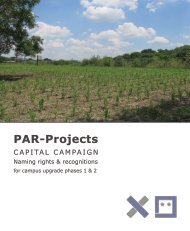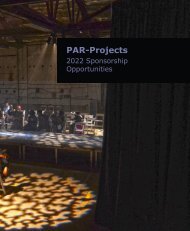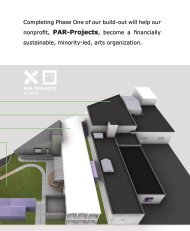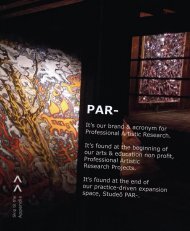PAR- Quarterly // Issue 01 // Quarter 2 Year 2022
Our first issue of PAR- Quarterly is LIVE! Check it out and let us know what you think?
Our first issue of PAR- Quarterly is LIVE!
Check it out and let us know what you think?
Create successful ePaper yourself
Turn your PDF publications into a flip-book with our unique Google optimized e-Paper software.
pq.<strong>01</strong><br />
04.22<br />
<strong>PAR</strong>- QUARTERLY<br />
<strong>Issue</strong> <strong>01</strong> <strong>Quarter</strong> 2<br />
YEAR <strong>2022</strong>
Table of Contents<br />
This <strong>Quarter</strong> @ <strong>PAR</strong>-<br />
This <strong>Quarter</strong> @ <strong>PAR</strong> .................................................. 2<br />
A Word From Jonathan ............................................. 3<br />
APRIL<br />
24 th | 11 am - 3 pm<br />
Beer Burger Brunch<br />
at <strong>PAR</strong>-Projects<br />
What’s In a Photo? ................................................... 6<br />
Studeo <strong>PAR</strong>- Highlight ............................................ 10<br />
In Case You Missed It ............................................. 11<br />
MAY<br />
21 st | 6 -10 pm<br />
Artist Talk w/Raymond<br />
Thompson, Jr. & Reception<br />
at Studeō <strong>PAR</strong>-<br />
Launching into Spring!<br />
During COVID, we’ve raised over $350,000 in<br />
donations & pledges! Now that spring is here,<br />
and we’re reopening, it’s time to go public<br />
with the community portion of our campaign.<br />
Click to learn more about this effort via<br />
JUNE<br />
29 th | noon - 6pm<br />
Final day to view Tunnelitis,<br />
currently on display in<br />
The Gallery at Studeō <strong>PAR</strong>-<br />
2
A word from Jonathan<br />
Some offerings will relate directly to our work at <strong>PAR</strong>-Projects while others may comment<br />
on trends in the industry. But to kick off this series, I offer a bit of personal reflection.<br />
Dr. Driskell: A quick reflection of soup & salad<br />
Most of our conversations, at least the most memorable ones, happened over lunch.<br />
Soup and salad; that’s what we did. We chatted about which fresh vegetables from<br />
the garden made it into that day’s lunch and we chatted about techniques that were<br />
perfected for that day’s soup. “Remember Jonathan, always save a little of your<br />
stock for the next batch. That’s how the French do it. It keeps your flavors alive —<br />
balanced.”<br />
The Dr. Driskell I knew was a humble man — an artist of media and an artist of<br />
life. And while we hung out in his Hyattsville studio from time to time, woodblock<br />
printing and encaustics weren’t really my thing, so our connections were much<br />
more about finding ways to live and breath as an artist. From time to time, he’d<br />
give me a lead on some art finds — a rare Romare Bearden for example — but<br />
really, most chats of ours were just about life. Still, he knew I was an obsessive<br />
maker in the digital media/sculpture realm, so from time to time he’d make sure<br />
to note that I needed to make it up to his Falmouth studio sometime. You know,<br />
connect as artists. But in those moments, all I could think was “...man, I wouldn’t<br />
be able to afford graduate school without your foundation. How am I gonna make<br />
it all the way up to Maine?!?” … Looking back though, I’m humbled that these<br />
Portrait by David Hill<br />
things were even a consideration. I guess walking amongst the greats is<br />
just the way it is sometimes.<br />
For the couple of years of graduate study that I was invited into his home to catalog<br />
slides and help Daphne and Rodney prepare to open what is now The David C.<br />
Driskell Center for the study of visual arts... at University of Maryland, I was<br />
blessed to gain a true appreciation and understanding of what success as a black<br />
artist could be. Well beyond notoriety, Dr. Driskell was surrounded by family and<br />
people like myself who genuinely cared about him, as a creative human, and never<br />
asked for much more than an inspirational story or even a quick recipe. Soup and<br />
salad was our jam, but man oh man, I can honestly say my life’s trajectory would<br />
have been much different had I not gained such an understanding of what life as a<br />
successful Black creative could be.<br />
So today — two years after Dr. Driskell’s untimely passing — I’d like to send some<br />
overdue thanks. To Daphne: Please know you changed my world. Thanks for being<br />
there and understanding that all nighters in the<br />
studio happened (maybe more frequently than<br />
they should have) and that sometimes I was<br />
just going pass out at work, mid sentence. To<br />
Rodney: Thanks for the overall joy and helping<br />
me to understand what life really could be. Your<br />
stories and presence are still very much a part of<br />
my driving force. And to Thelma & David: Please<br />
know your warmth was appreciated far more<br />
than I was ever able to articulate. I’m grateful<br />
that every memory I have with the two of you is<br />
filled with smiles and laughter. Aside from the<br />
spoken lessons, you gave me an amazing sense<br />
of what family could be. And to you all, if this<br />
post somehow finds you, please note that my<br />
center ended up happening in the humble town<br />
of Cincinnati and I’d love to tour you around<br />
our campus if the chance ever arises.<br />
Peace and blessings,<br />
Jonathan<br />
David Driskill,<br />
Jazz Singer (Lady of Leisure, Fox)<br />
1974<br />
3 4
WHAT’S IN A PHOTO?<br />
A candid conversation with Raymond Thompson Jr.<br />
by: Vic Mullins<br />
As the old saying goes, ‘a picture is<br />
worth a thousand words.’ This is still<br />
true in today’s galleries as artists work to<br />
maintain the delicate balance between<br />
self, story, and subject as they attempt<br />
to share untold stories and perspectives<br />
with the world.<br />
I had the wonderful opportunity to<br />
interview Raymond Thompson, Jr., an<br />
artist disguised as a photojournalist,<br />
whose project “Appalachian Ghosts” is<br />
on display in the Gallery at Studeo-<strong>PAR</strong><br />
as part of the Tunnelitis exhibition.<br />
was to be present in the landscape you’re in. I learned to take in the smells, tastes,<br />
and all that stuff. All those details really help you connect, which helps you make<br />
better photographs.”<br />
On being a Black kid in West Virginia:<br />
“Coming up as a Black male… in the 80s… the war on drugs was really raging on<br />
TV… and it’s like oh my God, I don’t like myself because all I’m seeing is these<br />
representations. Then combine that with all the pop culture representations and<br />
films, those constant Black males as predators really messed with my head.<br />
Later on in my career, I turned to photojournalism to help work through some of<br />
these issues, but I soon realized that maybe this wasn’t the right path for me.<br />
“...I lost faith in its inability to<br />
render Black people without<br />
bias. It got complex.”<br />
We chatted candidly about how he sojourns this path using his background in<br />
journalism to root his work creating subjective archives of the Black experience in<br />
American history.<br />
On his journey to photojournalism:<br />
“When I started school I wanted to be a biologist… something practical… so<br />
I stumbled through trying to find something super practical. But my Northern<br />
Virginia Community College had a photography class. So I started taking those<br />
darkroom classes and it was like ‘ooh this is cool.’<br />
I fell in love with photography then, but this still wasn’t really a career option at<br />
that point. But at some point, I ended up going for it. I ended up moving to Chicago<br />
to go to school there for a little bit, but I was broke, and photography is expensive.<br />
I could only afford two rolls of film each week. So that was 64 pictures each week<br />
to do all my photojournalism assignments. The most important lesson I learned<br />
The first project:<br />
During grad school, I did a project called “Justice Undone” which looked at the<br />
prison industrial complex through the lens of black communities. I was interested<br />
in examining the financial impact of mass incarceration on the ability of black<br />
communities to thrive.<br />
Then, things changed:<br />
Then in 2<strong>01</strong>6, I began to lose faith in journalism. I didn’t stop believing in it as an<br />
important part of understanding the world, but I lost faith in its ability to render<br />
Black people with bias. It got complex.<br />
I began to ask myself who am I making these images for? Am I making images to<br />
make Black bodies palatable to an audience that is most likely largely white folks?<br />
Is it allowing the white folks to say “Oh, at least I’m not them?” And that became<br />
problematic to me.<br />
5 6
A pivot of perspective:<br />
[Through my artistic practice ] “I want to pivot who my audience is. I hope the<br />
primary audience for my work is Black folks, then everyone else.”<br />
My first attempt at an art project was “Imaging/Imagining.” I read a book called<br />
Black Faces, White Spaces by Carolyn Finney. That book looks at the African<br />
American experience in the American landscape, so I started to think about my<br />
own experience with nature — like my family doesn’t camp.<br />
So where did that come from?<br />
I decided to google ‘white people in trees’ and ‘black people in trees’ and got two<br />
very different sets of pictures. One being leisure, enjoying wild spaces and the<br />
other being images that showed lynchings. So I wanted to contest this archive that<br />
I found of Black people in the woods and I wanted to make pictures of black folks<br />
engaging with the space. It was my first attempt at creating a speculative archive.<br />
Next time a Black person googles ‘black people in trees’ they’ll find my pictures too.<br />
I’m obsessed with HLT Quan’s phrase ‘It’s hard to stop a rebel who time travels.’<br />
I’m trying to manifest that idea in my work. I’m trying to weave past, present and<br />
future in a way I don’t understand yet.<br />
Deadline: May 31st<br />
We are now accepting applications for our first OPEN CALL<br />
in our new space — The Gallery at Studeō <strong>PAR</strong>-.<br />
Visit our website or the following link for more information.<br />
bit.ly/par-opencall<strong>2022</strong><br />
Click this sentence for more words and images from Raymond.<br />
7 8
In Case You Missed It<br />
During the month of February, <strong>PAR</strong>-Projects highlighted outstanding Black<br />
artists and our first artist highlight was James Hampton (1909-1964).<br />
While Mr. Hampton only created one collection of art in his lifetime, it was,<br />
quite simply, a masterpiece.<br />
Studeō <strong>PAR</strong>- Highlight<br />
Artist Doug Meyers of SkyVengers Cartoon is the Executive<br />
Director of the Cincinnati-based animation studio that is<br />
“dedicated to storytelling through digital media.” Meyers<br />
and SkyVengers moved into Studeō <strong>PAR</strong>- in May of 2020,<br />
becoming the building’s first long-term tenant.<br />
Meyers also serves on <strong>PAR</strong>-Projects’<br />
Education Committee, where<br />
he brings his passion and<br />
excitement for all aspects of<br />
arts education. We’re lucky<br />
to have him on board as we<br />
cultivate a close-knit creative<br />
community in Northside.<br />
The Throne of the Third Heaven of the Nations’ Millennium General Assembly<br />
is a massive collection of pieces inspired by a religious vision in preparation for the<br />
second coming of Christ.<br />
Created in a carriage house and entirely from plastic, cardboard and found items<br />
such as aluminum foil, discarded furniture, and used lightbulbs — from the office<br />
buildings where he worked as a janitor — this work 14 years to complete.<br />
Often regarded as “America’s greatest work of visual art,” the collection is both<br />
overwhelming and simplistic. It encompasses both the grandiosity of the return of<br />
the savior, and the humble instinct of an untrained artist to create.<br />
- Other examples of Black Art History can be found via our facebook page.<br />
9 10
Raymond Thompson Jr.<br />
Untitled<br />
from the “Dust” series<br />
<strong>PAR</strong>- Recommended... Art Links<br />
The Urgent Need To Train Writers To Effectively Explain Black Art<br />
David Driskell: Icons of Nature and History at Cincinnati Art Museum<br />
Black Prism presents Mos Def x Spencer Charles (NSFW)<br />
Need something different? Take a pottery class at Queen City Clay











